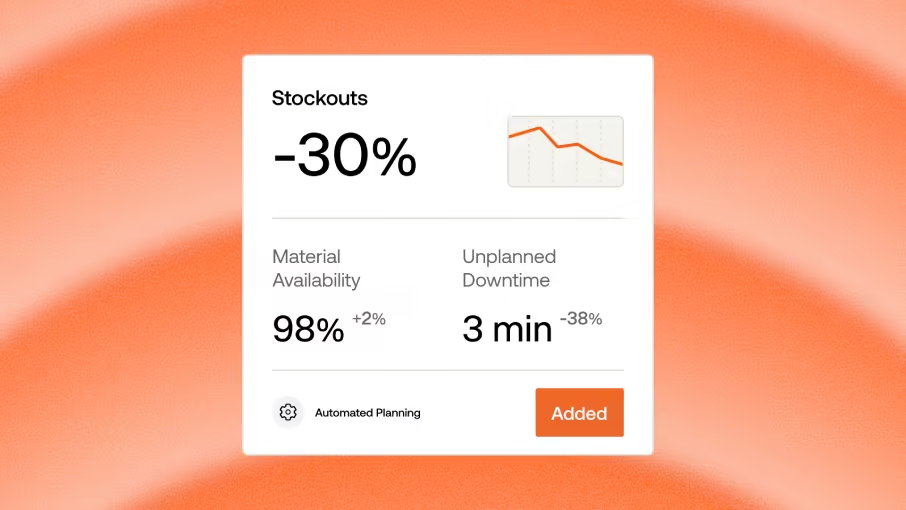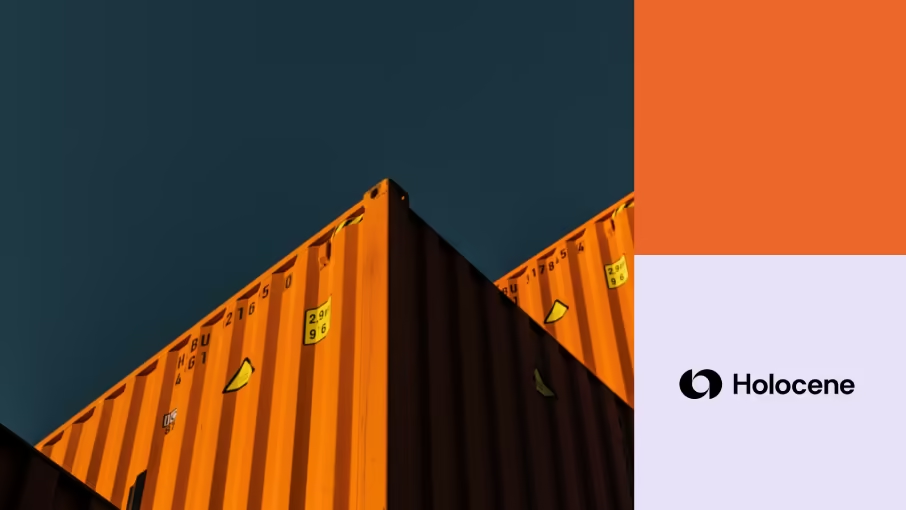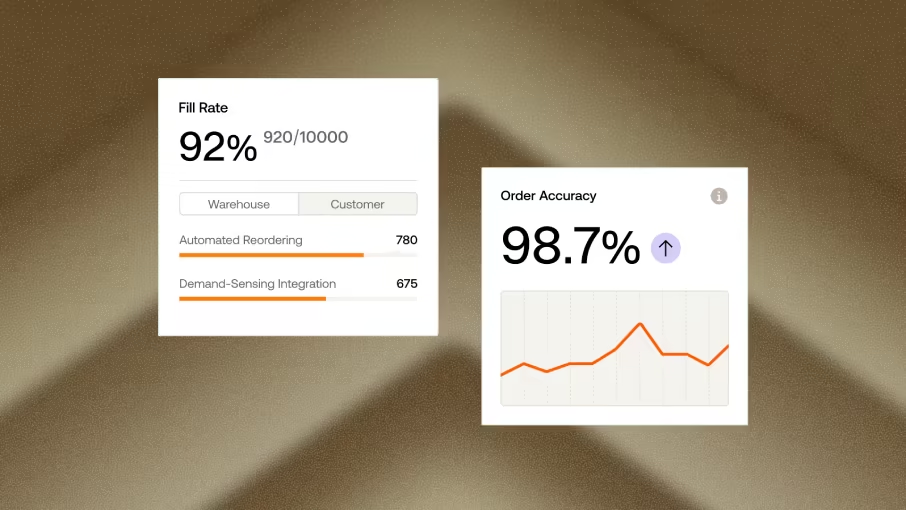Why Raw Material Inventory Is the Backbone of Resilient Manufacturing
Learn why raw material inventory is key to resilient manufacturing and how better execution helps avoid shortages and excess.

In manufacturing, managing raw material inventory isn’t just about having enough stock in the warehouse. It’s about having the right raw materials, at the right time, in the right place, in the correct quantity, staying ready, and staying agile, so that your production lines don’t starve due to a missing raw material. If you’re a manufacturer or have ever managed a supply chain, you know that when your raw material inventory is off, everything else goes off track.
In this article, let’s understand why managing raw material inventory is more crucial than ever, particularly when supply chains are under strain. We’ll walk through common challenges, the impact of inventory mismanagement, and how getting this part of the supply chain right sets the stage for better margins, better planning, and a more stable operation.
Why Raw Material Inventory Deserves a Closer Look
When manufacturers consider their inventories, they often focus solely on finished goods. However, the problem in the supply chain begins when raw material inventory is not properly managed. If raw materials don’t arrive on time, production stops. If you have too much, you’re sitting on cash that could be used elsewhere.
Managing raw material inventory is a delicate balance. According to a McKinsey report, disruptions in supply chains now cost the average company 45% of one year’s earnings over a decade. That’s a massive number, and a good chunk of it is tied to raw material shortages, late deliveries, or poor planning.
So what’s the real issue? In many cases, there’s a mismatch between what planning systems assume will happen and what is happening on the ground.
Types of Inventory Extremes: Too Much or Too Little
Most manufacturers find themselves at one of two ends:
- Too much inventory: You’ve over-ordered, often “just in case.” Warehouses are full. Your working capital is tied up. And the finance department is asking questions.
- Too little inventory or Shortages: You trusted your planning tool, but it was based on outdated or inaccurate lead times. Now you’re short, production is delayed, and there are expensive material expedites to put out fires.
Neither is good. What’s needed is precision in planning, i.e., knowing exactly how much to order and when based on real-world execution data.
What Causes Raw Material Inventory Problems?
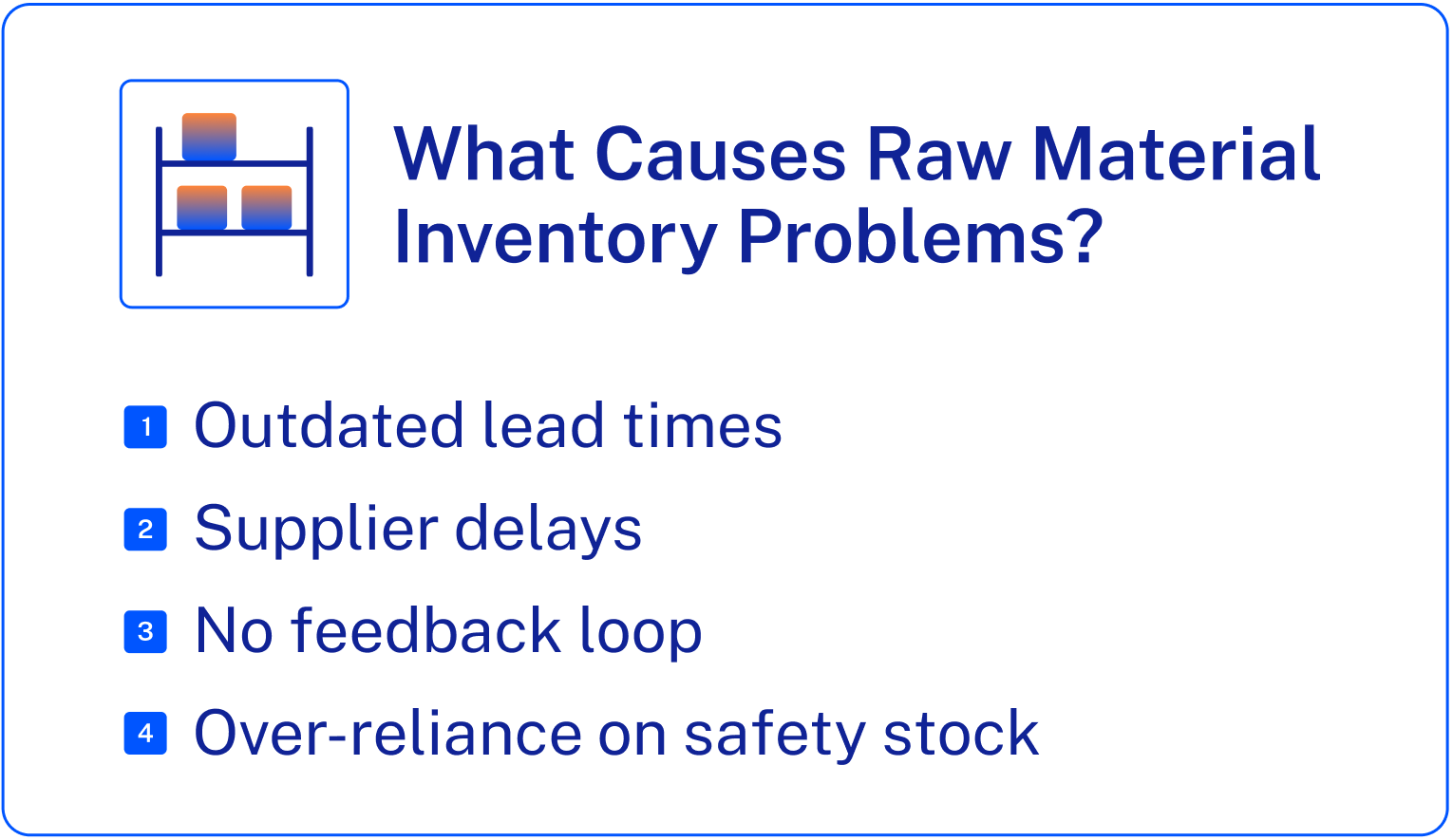
Here are a few of the most common issues that cause raw material inventory problems:
- Outdated lead times: Your planning system may assume it takes 25 days to get steel from China. However, lately, it has been taking 32. That gap leads to shortfalls.
- Supplier delays: Perhaps your supplier is experiencing delays due to a local holiday or a container being stuck at a port. If you don’t know this quickly, your plans are already off.
- No feedback loop: Planning and execution often fail to communicate with each other. When there’s a change, the planning layer isn’t updated. So, the same mistake keeps repeating.
- Over-reliance on safety stock: To avoid delays, companies pad inventory. However, excessive safety stock can add up. According to a study, excessive inventory can increase storage costs by 10% to 20% annually.
A recent situation that combined the problems above was the Suez Canal Blockage. It resulted in a daily loss of over $9.6 billion in goods. One stuck ship disrupted global supply chains, including raw materials such as plastics, electronic components, and metals. Such disruptions can cause significant inventory challenges throughout the supply chain, impacting both raw material and finished goods inventories.
Companies that were already tight on inventory had to shut down operations. However, those with better visibility into their supply chain could reroute shipments, update plans, and avoid line stops.
The takeaway? Visibility into raw material inventory is key. You need to know what’s happening now, not just what was planned.
Why It Matters Now
Today, raw material prices are unpredictable. According to Trading Economics, copper, aluminum, and crude oil have all experienced significant price fluctuations over the past 12 months. Changes in the market can directly impact raw material inventory strategies, requiring businesses to adapt quickly to shifting supply and demand conditions. Add to that labor shortages, political instability, and logistics bottlenecks — and it’s clear why raw material inventory must be rock-solid.
In times of uncertainty, companies that can control and predict their inputs stay ahead. Those that can’t end up paying more, in the form of expedited freight, lost production time, and unhappy customers.
The Holocene Approach: Fixing the Execution Gap
Many companies think the problem is bad planning. So, they invest in AI-powered planning tools. However, without real-time data from execution, even the smartest tool is left to guess.
That’s where Holocene comes in. Holocene helps manufacturers fix the gap between planning and what’s happening on the ground.
Here’s how:
- Real-time execution data: Holocene automatically captures updates from suppliers, logistics providers, and procurement — no need to chase emails or log into five different portals. With this real-time data, companies can determine and calculate key inventory metrics, such as inventory turnover ratios and reorder points, for more accurate decision-making.
- Self-healing master data: If lead times change, Holocene updates your system immediately, not after 20 days.
- Eliminating guesswork: You stop over-ordering to play it safe. And you avoid shortages because your plan is always up to date.
One Holocene customer, a multinational food and beverage company, reduced monthly raw material inventory by $8 million just by using real-time lead time updates. This reduction was calculated by determining accurate inventory values before and after implementation, highlighting the importance of precise inventory assessment. That’s not theory. That’s cash back in the business.
The Impact on Procurement and Planning
When raw material inventory is under control, everything improves:
- Procurement knows when to place orders, can negotiate better terms because they’re not rushing, and can optimize purchase timing and costs.
- Production planners can trust the system. They’re not scrambling because something didn’t arrive on time.
- Finance sees better cash flow. Less working capital is stuck in warehouses, and inventory management directly impacts accounts and the company's account structure.
- Warehouse teams have room to breathe. No more containers showing up with nowhere to store them.
Efficient inventory management also supports sales by ensuring products are available to sell quickly, which improves the company's sales performance and helps the business sells more inventory.
And it’s not just about preventing problems. It’s about unlocking performance.
What About Just-in-Time?
Just-in-time (JIT) is great in theory — but it depends on precision. If your lead time is always 50 days and you trust that number, you can plan accordingly. But if it’s 50 today and 60 next week, you need better visibility.
Holocene doesn’t tell companies to move away from JIT. It gives them the confidence to do it, without risking line stops.
Common Missteps to Avoid
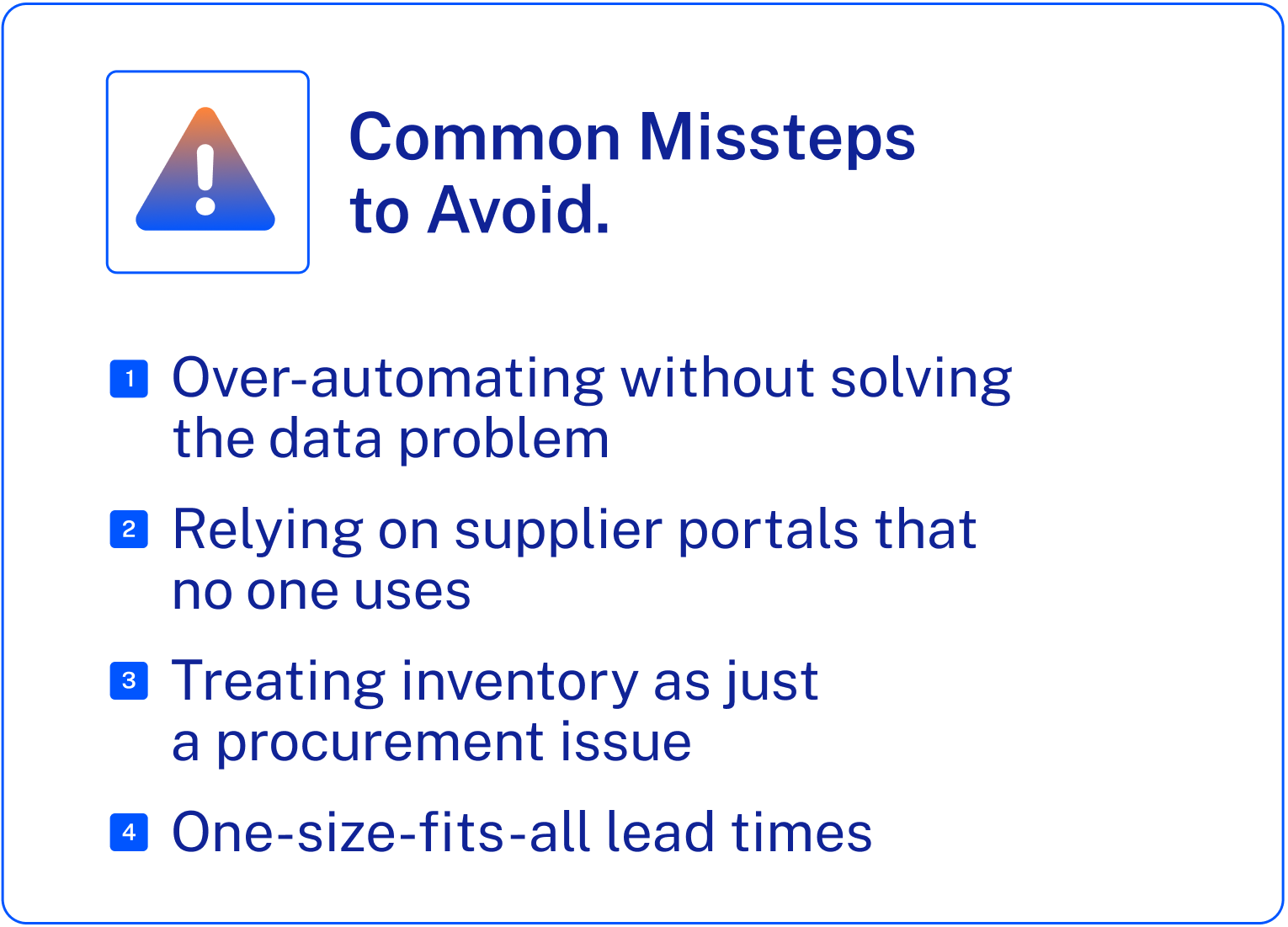
These common missteps in inventory management can significantly impact any manufacturing company, regardless of size, by disrupting operations.
- Over-automating without solving the data problem: If your planning tool runs on bad data, it’ll continue to make poor decisions more quickly.
- Relying on supplier portals that no one uses: If suppliers don’t update the portal, your system is still flying blind.
- Treating inventory as just a procurement issue: It’s not. Inventory sits at the intersection of planning, execution, logistics, and finance. Everyone needs to be on the same page.
- One-size-fits-all lead times: Different suppliers behave differently. Even the same supplier may perform differently across different materials.
The Holocene Difference: No More Portals
One of the smartest aspects of Holocene is that it doesn’t require suppliers to change their working methods. No portals. No new systems. It captures execution intelligence passively — from emails, updates, invoices, and more.
This makes it easy for suppliers. And it means companies don’t have to wait months for adoption.
If you’re not already examining your raw material inventory with a fresh perspective, now is the time. This isn’t about micromanaging or second-guessing your teams. It’s about providing them with the tools and data to perform their jobs more effectively.
Start by asking:
- Do we know the real lead time for our top 50 materials?
- How often is that number updated in our planning system?
- How long does it take for supplier delays to reach our planners?
- Are we over-ordering just to feel safe?
Want to Stop Firefighting and Start Improving?
At Holocene, we help manufacturers address their raw material inventory challenges without disrupting their suppliers' operations — no more waiting for updates, guessing lead times, or juggling spreadsheets.
Let's talk about how better execution intelligence can help you reduce inventory, improve planning, and build a more resilient supply chain together.
Frequently Asked Questions (FAQs)
1. Why is raw material inventory so critical to a manufacturing business?
Raw material inventory is a current asset on a company's balance sheet and the foundation of the entire manufacturing process. Without the right raw materials available, a business can’t produce its own products efficiently, which slows down revenue generation. Managing this inventory ensures that resources are used effectively, and helps manufacturers make informed decisions that align with customer demand and production capacity.
2. How does raw material inventory affect the cost of goods sold and the income statement?
Raw material inventory directly impacts the total cost of goods sold (COGS) reported on the income statement. At the beginning of a period, companies calculate the average value of raw materials on hand, factor in purchases, and then subtract the ending inventory to determine what was used. Mismanaging inventory levels can lead to inflated COGS or underreported profits, distorting financial performance and hurting cash flow.
3. What’s the difference between raw material inventory and work in progress inventory?
Raw material inventory consists of the basic materials used to produce goods, whereas work in progress (WIP) inventory includes partially finished goods still moving through the production process. Both are essential to tracking inventory changes over time and understanding where resources are tied up within a manufacturing business.
4. How can manufacturers save money with better inventory management?
Accurate inventory data helps reduce inventory costs by preventing over-ordering and storage of excess raw materials. By making efficient use of existing resources and implementing real-time updates, companies can avoid emergency shipments, streamline the manufacturing process, and ultimately save money while boosting on-time delivery performance. It's about aligning supply with customer demand while keeping working capital lean.
5. How does Holocene help track raw materials inventory turnover?
Holocene calculates raw materials inventory turnover by analyzing how often raw materials are used and replenished during a set period. This metric is critical for measuring the efficient use of inventory. By monitoring inventory flows in real time, Holocene helps companies maintain the right balance between holding too much or too little, ensuring the production process runs smoothly and costs stay under control.
6. What role do periodic inventory systems play in raw materials management?
Periodic inventory systems update inventory balances at the end of each accounting period, rather than in real time. While simpler to manage, they can lead to blind spots in rapidly changing environments. For manufacturers, especially those dealing with volatile customer demand or frequent inventory changes, relying solely on periodic updates can delay informed decisions. Systems like Holocene complement or replace periodic tracking by offering real-time visibility across the supply chain.


